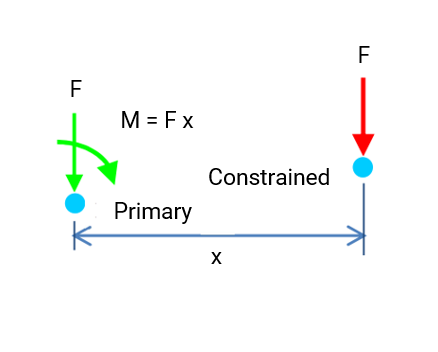Constraints
Constraints are where a condition is applied to a degree of freedom in the model. They may be defined as:
Constraints can all be represented as constraints equations:
Restraints
Restraints specify degrees of freedom that are restrained from movement such that .
In GSA, restraints can be applied in Node properties:
If using staged analysis, restraints can be defined differently for each stage. See the references entry on generalised restraints entry for further guidance on restraints that move between stages.
Settlements
Settlements are when a degree of freedom is forced into a displaced position such that .
Settlements can be applied to any restrained node by applying a settlement load. A different settlement can be defined for each load case.
Joints
Joints describe the condition where two degrees of freedom in the model are linked in a given direction such that .
They relate the displacement or force at the constrained degree of freedom, () to the primary degree of freedom ().
Note: Joints are an artificial feature and might not give an equilibrium condition if the nodes are not coincident or have the same axes.

Rigid constraints
Rigid constraints are similar to joints in that it relates the constrained degrees of freedom to the primary degree of freedom. However, unlike joints, they are a set of constraint equations that maintain equilibrium.
For a rigid constraint in the plane, the equations relating constrained to primary are:

Rigid constraints can be applied in all directions or applied to a specified plane.
- The primary node can be restrained or constrained by another constraint.
- The constrained node cannot be restrained or be a constrained by another constraint.
- A rigid constraint can be considered as a rigid body or rigid plane, depending on the type of its property.
The rigid constraint can have the following properties:
| Plane | Properties |
|---|---|
| All | Rigid constraint applied to all directions (a rigid body) |
| XY plane | Rigid constraint applied to XY plane only (a rigid plane) |
| YZ plane | Rigid constraint applied to YZ plane only (a rigid plane) |
| ZX plane | Rigid constraint applied to ZX plane only (a rigid plane) |
| Pin all | Same as 'All', except that the moment at the constrained node is not included in the constraint |
| Pin XY plane | Same as 'XY plane', except that the moment at the constrained node is not included in the constraint |
| Pin YZ plane | Same as 'YZ plane', except that the moment at the constrained node is not included in the constraint |
| Pin ZX plane | Same as 'ZX plane', except that the moment at the constrained node is not included in the constraint |